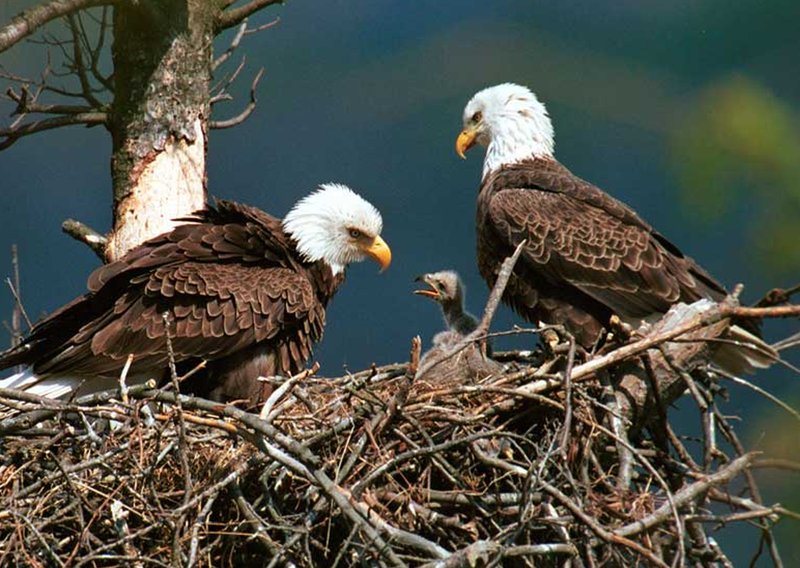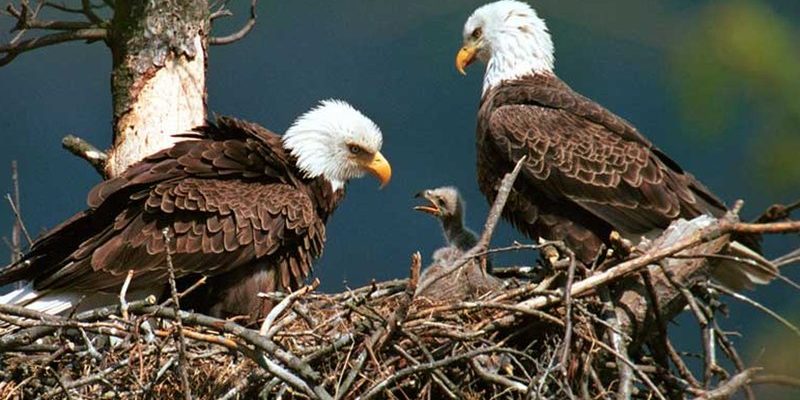
When we talk about eagles, we often think of the iconic bald eagle, known for its striking white head and bright yellow beak. But there are other species, like the golden eagle, which also have incredible nesting behaviors. Both types share a common thread: their nesting habits are carefully crafted over years, serving not just as homes, but as safe havens for raising their young. So, let’s dive into the remarkable world of eagle nesting and their lifecycle, shall we?
Where Do Eagles Build Their Nests?
Eagles are known for building their nests in high, secluded locations. They typically choose tall trees or cliffs that provide a great vantage point and protection from predators. Many bald eagles, for example, prefer to build their nests near rivers, lakes, or coastal areas where food is plentiful. Here’s a little story: Picture an eagle perched on a high branch, its sharp eyesight scanning the water below for fish. This perfect spot not only offers a meal but also a safe place to raise their chicks.
The nests themselves are quite impressive, often measuring up to 10 feet in diameter and weighing over a thousand pounds! Eagles gather twigs, branches, and other materials to build their homes. They’ll often reuse the same nest year after year, adding more layers and materials each time. It’s like they’re creating a cozy, evolving nest for their growing family.
The Nesting Season: Timing is Everything
Eagle nesting habits are deeply connected to the seasons. Typically, eagles begin their nesting activities in late winter, around January to March, depending on their location. During this time, you might hear the sound of twigs snapping as they reinforce their nests. Just imagine the anticipation building as they prepare for the arrival of new life!
Once the nest is ready, the female eagle usually lays one to three eggs. These eggs are a beautiful shade of white, and both parents take turns incubating them for about 35 days. This shared responsibility is crucial—they work together, ensuring the eggs stay warm and safe from any threats. You might be wondering why teamwork is so important. Well, the survival of their chicks depends on it!
The Hatching Process: A New Beginning
After weeks of anticipation, the hatching process is nothing short of magical. The little eaglets break free from their eggs with great effort, typically in late March or early April. This stage is akin to a grand debut, as the tiny chicks emerge into the world, fluffy and vulnerable. At this point, you can imagine the excitement in the nest—everything is new and thrilling!
Hatched eaglets rely heavily on their parents for food and warmth. Initially, they’re completely dependent, unable to regulate their own temperatures. During this time, the parents are busy hunting and bringing food back to the nest. You might think of them as a dynamic duo, working tirelessly to ensure their offspring grow strong and healthy.
Feeding the Eaglets: Growth and Development
As the eaglets grow, their needs change. You might be surprised to know that eaglets can consume a staggering amount of food—up to a quarter of their body weight! The parents play a vital role here, bringing back fish, small mammals, and even carrion to help nourish their young. This constant supply of food is essential for the eaglets’ rapid growth.
The eaglets grow quickly, developing feathers and strength. Around 10 weeks after hatching, they’re ready to flap their wings and explore the world outside their nest. It’s like sending a child off to camp for the first time—they’re excited, and a little nervous, but ready to spread their wings.
Fledging: Taking the Leap
Fledging is a significant milestone in an eagle’s lifecycle. This process usually occurs between 10 to 12 weeks after the eggs hatch. At this stage, the eaglets take their first flight, a moment filled with both fear and exhilaration. Imagine the thrill of standing on the edge of a cliff, ready to leap into the vast sky!
During their initial flights, eaglets practice soaring and landing, developing their skills. Interestingly, they often stay close to the nest for a few weeks, returning for food and safety. This period is crucial for learning how to hunt and navigate their surroundings.
Maturation and Independence: Beginning the Journey
After fledging, eagles gradually gain independence. Over the next few months, they’ll hone their hunting skills under the watchful eye of their parents. You might think of this as an apprenticeship—learning the ropes before flying solo. By the time they are around 4 to 5 months old, they’re ready to start living independently.
It’s critical for the young eagles to master these survival skills. They need to find their own nests and territories. Interestingly, some young eagles may stay near their parents for a year or two before fully venturing out on their own. This extended period provides valuable learning experiences and helps them adapt to life without parental support.
The Lifespan of Eagles: A Journey of Survival
Eagles can live quite a long life, often reaching 20 to 30 years in the wild. Their lifespan can depend on various factors, including habitat quality, food availability, and threats from human encroachment or pollution. You might be surprised to learn that many eagles return to the same nesting sites year after year, creating a legacy in the same area.
As adult eagles, they often pair up for life, maintaining strong bonds with their mates. This commitment is not just romantic; it’s a partnership critical for successfully raising the next generation of eagles. Their ability to adapt and thrive is part of what makes them such remarkable birds.
In conclusion, the entire lifecycle of an eagle, from nest building to fledging, is a testament to their resilience and adaptability. Understanding their nesting habits is key to appreciating these magnificent birds and the role they play in our ecosystem. Next time you see one soaring overhead, you might just think about the incredible journey it took to get there!

